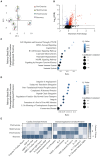Exercise-Dependent Modulation of Immunological Response Pathways in Endurance Athletes With and Without Atrial Fibrillation
- PMID: 38497478
- PMCID: PMC11009995
- DOI: 10.1161/JAHA.123.033640
Exercise-Dependent Modulation of Immunological Response Pathways in Endurance Athletes With and Without Atrial Fibrillation
Abstract
Background: Atrial fibrillation (AF) is a common arrhythmia characterized by uncoordinated atrial electrical activity. Lone AF occurs in the absence of traditional risk factors and is frequently observed in male endurance athletes, who face a 2- to 5-fold higher risk of AF compared with healthy, moderately active males. Our understanding of how endurance exercise contributes to the pathophysiology of lone AF remains limited. This study aimed to characterize the circulating protein fluctuations during high-intensity exercise as well as explore potential biomarkers of exercise-associated AF.
Methods and results: A prospective cohort of 12 male endurance cyclists between the ages of 40 and 65 years, 6 of whom had a history of exercise-associated AF, were recruited to participate using a convenience sampling method. The circulating proteome was subsequently analyzed using multiplex immunoassays and aptamer-based proteomics before, during, and after an acute high-intensity endurance exercise bout to assess temporality and identify potential markers of AF. The endurance exercise bout resulted in significant alterations to proteins involved in immune modulation (eg, growth/differentiation factor 15), skeletal muscle metabolism (eg, α-actinin-2), cell death (eg, histones), and inflammation (eg, interleukin-6). Subjects with AF differed from those without, displaying modulation of proteins previously known to have associations with incident AF (eg, C-reactive protein, insulin-like growth factor-1, and angiopoietin-2), and also with proteins having no previous association (eg, tapasin-related protein and α2-Heremans-Schmid glycoprotein).
Conclusions: These findings provide insights into the proteomic response to acute intense exercise, provide mechanistic insights into the pathophysiology behind AF in athletes, and identify targets for future study and validation.
Keywords: endurance athletes; exercise; lone atrial fibrillation; proteomics.
Figures




Similar articles
-
Physical activity, symptoms, medication and subjective health among veteran endurance athletes with atrial fibrillation.Clin Res Cardiol. 2016 Feb;105(2):154-61. doi: 10.1007/s00392-015-0898-0. Epub 2015 Jul 26. Clin Res Cardiol. 2016. PMID: 26210772
-
Efficacy of circumferential pulmonary vein ablation of atrial fibrillation in endurance athletes.Europace. 2010 Jan;12(1):30-6. doi: 10.1093/europace/eup320. Europace. 2010. PMID: 19923171 Free PMC article.
-
Right Heart Structure and Function in Lifelong Recreational Endurance Athletes with and without Paroxysmal Atrial Fibrillation.J Am Soc Echocardiogr. 2022 Dec;35(12):1259-1268. doi: 10.1016/j.echo.2022.06.008. Epub 2022 Jun 26. J Am Soc Echocardiogr. 2022. PMID: 35760278
-
Atrial fibrillation in highly trained endurance athletes - Description of a syndrome.Int J Cardiol. 2017 Jan 1;226:11-20. doi: 10.1016/j.ijcard.2016.10.047. Epub 2016 Oct 19. Int J Cardiol. 2017. PMID: 27776250 Review.
-
Atrial fibrillation in endurance athletes.Eur J Prev Cardiol. 2014 Aug;21(8):1040-8. doi: 10.1177/2047487313476414. Epub 2013 Jan 30. Eur J Prev Cardiol. 2014. PMID: 23610454 Review.
Cited by
-
Exercise and Atrial Fibrillation: Current Evidence, Knowledge Gaps, and Future Directions.Rev Cardiovasc Med. 2025 Jul 28;26(7):39200. doi: 10.31083/RCM39200. eCollection 2025 Jul. Rev Cardiovasc Med. 2025. PMID: 40776961 Free PMC article. Review.
-
Cardiovascular Remodeling and Potential Controversies in Master Endurance Athletes-A Narrative Review.Life (Basel). 2025 Jul 12;15(7):1095. doi: 10.3390/life15071095. Life (Basel). 2025. PMID: 40724596 Free PMC article. Review.
References
-
- Huxley RR, Lopez FL, Folsom AR, Agarwal SK, Loehr LR, Soliman EZ, Maclehose R, Konety S, Alonso A. Absolute and attributable risks of atrial fibrillation in relation to optimal and borderline risk factors: the Atherosclerosis Risk in Communities (ARIC) study. Circulation. 2011;123:1501–1508. doi: 10.1161/CIRCULATIONAHA.110.009035 - DOI - PMC - PubMed
-
- Greulich S, Maxhera B, Vandenplas G, de Wiza DH, Smiris K, Mueller H, Heinrichs J, Blumensatt M, Cuvelier C, Akhyari P. Secretory products from epicardial adipose tissue of patients with type 2 diabetes mellitus induce cardiomyocyte dysfunction. Circulation. 2012;126:2324–2334. doi: 10.1161/CIRCULATIONAHA.111.039586 - DOI - PubMed
MeSH terms
LinkOut - more resources
Full Text Sources
Medical
Research Materials

